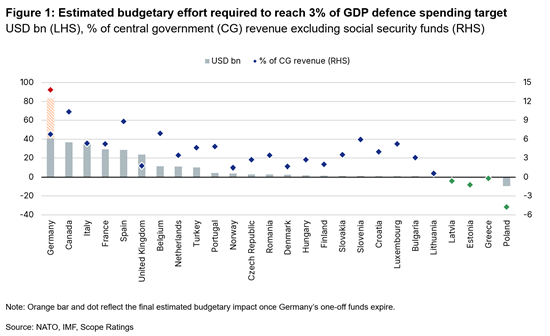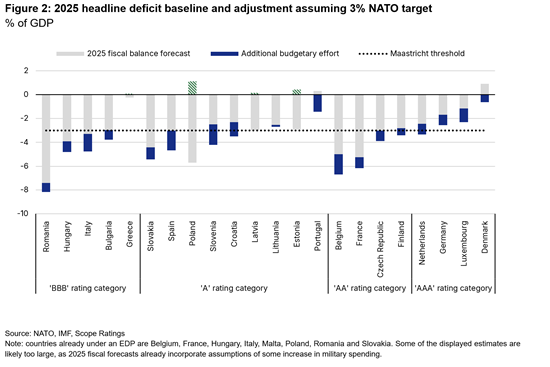Announcements
Drinks
Higher defence spending to weaken EU credit profiles, even if fiscal rules eased
NATO’s EU member states would need to allocate, on average, an additional 0.8% of GDP each year to meet an increase in defence expenditure to 3% of GDP from the current NATO target of 2%. However, the budgetary impact relative to revenues varies widely across countries.
Spain (A/Stable) faces the largest budgetary impact of around 8.8% of central government revenues, followed by Germany (AAA/Stable) and Belgium (AA-/Negative), both close to 7%. Spain’s and Belgium’s position reflects their relatively small military budget, running at around 1.3% of GDP.
However, once Germany’s special defence expenditure fund of EUR 100bn is depleted by end-of 2026, its budgetary gap would be the largest among EU member states at around 13.8% of central government revenues. This compares with Italy’s and France’s budgetary impact of around 5%.
In absolute terms, Germany’s defence spending shortfall would also be the largest, standing at around USD 40.6bn in 2025 and 2026 but almost USD 83bn from 2027, more than twice that of Italy (USD 35bn), France (USD 29bn), and Spain (USD 28.5bn).
Meeting the 3% target would require more than one-quarter of Germany’s budget to be allocated to defence. Substantially reducing expenditure elsewhere or raising taxes appears highly unlikely. The incoming government may therefore have to rely on renewed special funds, approval for which would require a two thirds parliamentary majority.

Higher defence spending to weaken fiscal metrics, even if EU fiscal rules eased
Germany, however, is among the few member states fiscally able to absorb the expected defence-expenditure shock, together with sovereigns already meeting the adjusted target (Greece, Poland and the Baltic States) and/or countries with fiscal space such as Portugal and the AAA-rated member states.
Conversely, meeting higher defence expenditure would likely result in EU excessive deficit procedures (EDP) for several countries already unable to reduce their budget deficits to below 3% in the coming years (Figure 2).

The additional budgetary burden would significantly raise the hurdle for consolidation for several countries already under an EDP, including France (AA-/Stable), Belgium, and Italy (BBB+/Stable). The fiscal effort, if implemented, would also raise the likelihood that other countries may fall under an EDP, such as Slovenia (A/Stable) and Spain.
Allowing greater flexibility in the EU’s fiscal rules would reduce the likelihood of EDPs and potentially mitigate stigma among some market participants.
However, from a credit rating perspective, any assessment goes beyond the compliance with fiscal rules. We focus on the country's broader fiscal stance, and thus budget balances, the sustainability of interest payments, and medium-term debt trajectories.
Higher defence expenditure would lead to higher borrowings and deteriorating debt-to-GDP trajectories in most EU countries, and thus weaker sovereign credit profiles, unless governments reduce spending elsewhere or increase revenues.
Financing defence and security at the EU level
Given the limited fiscal space among several EU member states, and Germany’s challenge of facing by far the largest budgetary impact in meeting a revised defence expenditure target from 2027, the financing of security, defence and the reconstruction of Ukraine could be increasingly shifted to the European level. This would most likely involve either the EU and/or other AAA-rated supranational institutions such as the European Investment Bank (EIB) and the European Bank for Reconstruction and Development (EBRD)*.
Centralising EU security and defence financing could provide more sustainable and coordinated financing across member states while also creating economies of scale in defence and security procurement. Such a move would mark a significant political step towards deeper European integration. In addition, depending on the design of the financial instrument, it could also contribute to a permanent increase in the supply of European safe assets, strengthening financial stability across the region.
As the US reassesses its role in the military alliance, upward pressure on defence spending in Europe is one of four main risks to the region’s sovereign credit outlook unless European governments find common ground and make bold reforms (see Scope’s recent research: EU sovereigns face multiple risks to credit outlook from shifts in US policy).
* Investments in the defence and security sectors are subject to dual-use requirements and exclusion criteria for weapons and ammunition.






